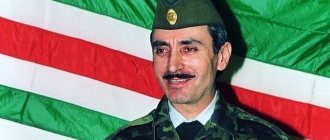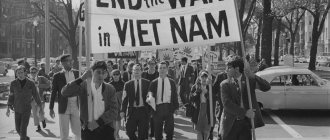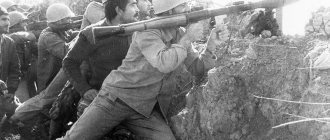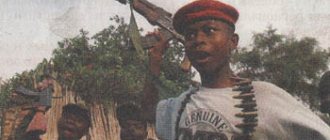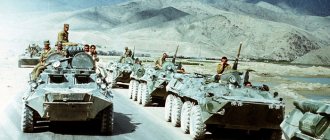4.3
Average rating: 4.3
Total ratings received: 3132.
4.3
Average rating: 4.3
Total ratings received: 3132.
In the second half of the twentieth century, a confrontation between the two strongest powers of their time unfolded on the world political stage: the USA and the USSR. In 1960-80 it reached its climax and was defined as the “Cold War”. The struggle for influence in all spheres, spy wars, the arms race, the expansion of “their” regimes are the main signs of the relationship between the two superpowers.
The material was prepared jointly with a teacher of the highest category, Ekaterina Valerievna Alexandrova.
Experience as a history and social studies teacher - 11 years.
Prerequisites for the emergence of the Cold War
After the end of World War II, two countries turned out to be the most powerful politically and economically: the United States and the Soviet Union. Each of them had great influence in the world, and sought in every possible way to strengthen their leadership positions.
In the eyes of the world community, the USSR was losing its usual image of an enemy. Many European countries, devastated after the war, began to show increased interest in the experience of rapid industrialization in the USSR. Socialism began to attract millions of people as a means of overcoming devastation.
In addition, the influence of the USSR significantly expanded to the countries of Asia and Eastern Europe, where communist parties came to power.
Concerned by such a rapid growth in the popularity of the Soviets, the Western world began to take decisive action. In 1946, in the American city of Fulton, former British Prime Minister Winston Churchill delivered his famous speech, in which the whole world accused the Soviet Union of aggressive expansion, and called on the entire Anglo-Saxon world to give it a decisive rebuff.
Rice. 1. Churchill's speech in Fulton.
The “Truman Doctrine” to contain communism, which he introduced in 1947, further worsened the USSR’s relations with its former allies. This position assumed:
- Providing economic assistance to European powers.
- Formation of a military-political bloc under the leadership of the United States.
- Placement of American military bases along the border with the Soviet Union.
- Support for opposition forces in Eastern European countries.
- Use of nuclear weapons.
Churchill's Fulton speech and the Truman Doctrine were perceived by the USSR government as a threat and a kind of declaration of war.
TOP 4 articles
who are reading along with this
Berlin crisis
Cuban missile crisis of 1962 in brief
Causes of the Cold War
Beginning of the Cold War
Marshall Plan
J. Marshall. US Secretary of State 1947-1949
The Marshall Plan , a program of assistance to Europe after World War II, was put forward in 1947 by American Secretary of State George C. Marshall. The stated goal of the plan by the United States was to restore the European economy, eliminate trade barriers, and modernize the industry of European countries. At the same time, the Americans, as a precondition for providing assistance, demanded the removal of the communists from the governments of the countries that signed the treaty. A number of agreements accompanying the plan impeded free trade among the countries receiving aid, most notably the prohibition of trade between East and West. The implementation of the Marshall Plan established the dependence of Western European countries on the United States.
Main stages of the Cold War
1946-1991 - the years of the beginning and end of the Cold War. During this period, conflicts between the USA and the USSR either died down or flared up with renewed vigor.
The confrontation between countries was not conducted openly, but with the help of political, ideological and economic levers of influence. Despite the fact that the confrontation between the two powers did not result in a “hot” war, they still took part on opposite sides of the barricades in local military conflicts.
- Cuban Missile Crisis (1962). During the Cuban Revolution in 1959, power in the state was seized by “pro-Soviet” forces led by Fidel Castro. Fearing aggression from a new neighbor, US President Kennedy placed nuclear missiles in Turkey, on the border with the USSR. In response to these actions, Soviet leader Nikita Khrushchev ordered the stationing of missiles in Cuba. A nuclear war could start at any moment, but as a result of the agreement, weapons were removed from the border regions of both sides.
Rice.
2. Caribbean crisis. Realizing how dangerous manipulation of nuclear weapons is, in 1963 the USSR, USA and Great Britain signed a Treaty banning the testing of nuclear weapons in three areas (in the atmosphere, in space and under water). Subsequently, a new Treaty on the Non-Proliferation of Nuclear Weapons was also signed.
- Berlin crisis (1961). At the end of World War II, Berlin was divided into two parts: the eastern part belonged to the USSR, the western part was controlled by the United States. The confrontation between the two countries grew more and more, and the threat of the Third World War became more and more tangible. On August 13, 1961, the so-called “Berlin Wall” was erected, dividing the city into two parts. This date can be called the apogee and the beginning of the decline of the Cold War between the USSR and the USA.
Rice. 3. Berlin Wall.
- Vietnam War (1965). The United States started the war in Vietnam, divided into two camps: North Vietnam supported socialism, and South Vietnam supported capitalism. The USSR secretly participated in the military conflict, supporting the northerners in every possible way. However, this war caused an unprecedented resonance in society, in particular in America, and after numerous protests and demonstrations it was stopped.
Results
The main result of the Cold War was the failure of the alternative communist system and the ineffectiveness of the planned economy. Yes, of course, capitalism, a market economy, and democracy also have their many disadvantages. But despite them, this is “the best thing that has been invented by mankind.” Since the alternative is much worse, which is shown today by the example of the same North Korea, which has turned into a rogue state, a country where in the 90s there was a real famine that killed thousands of people. While neighboring South Korea is one of the most economically developed and successful countries in the Eastern region.
As for neighboring China, which is nominally still communist, but capitalism and market relations have been actively developing there since the 90s, which has allowed China to become the “global forge of goods.” In fact, China now represents “efficient capitalism under the nominal leadership of the Communist Party.”
Consequences of the Cold War
Relations between the USSR and the USA continued to be ambiguous, and conflict situations flared up between the countries more than once. However, in the second half of the 1980s, when Gorbachev was in power in the USSR and Reagan ruled the USA, the Cold War gradually came to an end. Its final completion occurred in 1991, along with the collapse of the Soviet Union.
The Cold War period was very acute not only for the USSR and the USA. The threat of a Third World War using nuclear weapons, the split of the world into two opposing camps, the arms race, and rivalry in all spheres of life kept all of humanity in suspense for several decades.
Literature and useful links
- J. Arnold, J. Burt, W. Dudley. Flame of the Cold War: Victories that never happened = Cold War Hot: Alternative Decisions of the Cold War / ed. Peter Tsouros (English)Russian, trans. Yu. Yablokova. - M.: AST, Lux, 2004. - 480 p. - (Great Controversies). — 5000 copies. — ISBN 5-17-024051-1.
- Creder A.A. Recent history of foreign countries. 1914 - 1997: Textbook for 9th grade of primary school. — 2nd ed., add. and correction. - M.: "Center for Humanitarian Education", 2005. - 432 p. — ISBN 5-7662-0062-5.
- Cold War / Egorova N. I. // Khvoyka - Shervinsky. - M.: Great Russian Encyclopedia, 2022. - P. 132. - (Big Russian Encyclopedia: [in 35 volumes] / chief editor Yu. S. Osipov; 2004-2017, vol. 34). — ISBN 978-5-85270-372-9.
- V. Manjola. “Cold War” // Ukrainian Diplomatic Encyclopedia: 2 volumes / ed. number: L.V. Gubersky (head) and in. - K.: Zannanya Ukrainy, 2004. - T. 2: M - Y. - 812 p. — ISBN 966-316-045-4.
Author: Pavel Chaika, editor-in-chief of the historical site Time Travel
When writing the article, I tried to make it as interesting, useful and high-quality as possible. I would be grateful for any feedback and constructive criticism in the form of comments on the article. You can also write your wish/question/suggestion to my email [email protected] or Facebook, with respect, the author.
Historical site Time Travel
Prague Spring 1968
Operation Danube. Prague, 1968
Prague Spring (January 5 - August 21, 1968) - a period of liberalization in Czechoslovakia associated with the reforms of the first secretary of the Central Committee of the Communist Party of Czechoslovakia Alexander Dubcek. Simultaneously with liberalization, anti-Soviet sentiments grew in society, perceived by the leadership of the USSR as a threat to the integrity and security of the socialist camp. On August 21, 1968, Operation Danube began - the introduction of Warsaw Pact troops into Czechoslovakia with the aim of displacing the country's leadership and preventing Czechoslovakia from leaving the socialist bloc. The reformers were arrested and taken to Moscow, where a program was adopted to curtail reforms and station a contingent of Soviet troops in Czechoslovakia. The events of the Prague Spring were used by the United States to organize large-scale anti-Soviet propaganda.
Hungarian uprising 1956
Operation Whirlwind. Budapest, 1956
The Hungarian Uprising of 1956 was an armed uprising against the pro-Soviet regime in Hungary. In 1953, the Hungarian government was headed by Imre Nagy, whose reform course aroused criticism in the USSR. In 1955, I. Nagy was removed and the reforms were curtailed. This caused discontent in society. In October 1956, armed clashes between protesters and GB and army units began. I. Nagy, who again headed the government, took the side of the protesters. On November 4, Operation Whirlwind began - Soviet troops (more than 30 thousand people) were brought into Hungary. On November 11, the uprising was suppressed throughout the country. I. Nagy was hanged on June 16, 1958 for “treason and organizing a conspiracy.” In total, at least 600 death sentences were imposed on participants in the rebellion.
Blockade of West Berlin 1948
Air corridor. Berlin, 1948
Blockade of West Berlin (First Berlin Crisis) (June 24, 1948 - May 11, 1949) - a blockade by the Soviet Union of road and railway routes of the Western Allies through the territory of East Germany, into the western sectors of Berlin under their control. The blockade was a response to the US intention to include West Berlin in the scope of the Marshall Plan. To overcome the blockade, the Western allies organized an air bridge. The Berlin crisis accelerated the unification of the western zone of occupation into the Federal Republic of Germany in May 1949, with West Berlin becoming an autonomous self-governing city connected by land corridor with the Federal Republic of Germany. In response to this, the German Democratic Republic was created in October 1949 in the Soviet zone of occupation.
